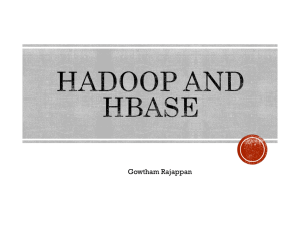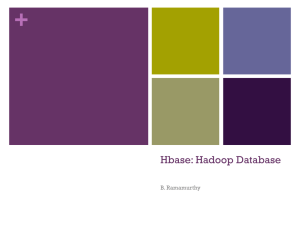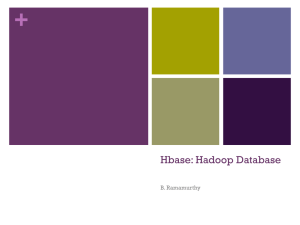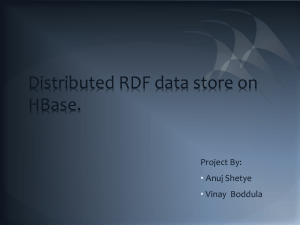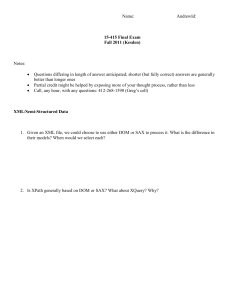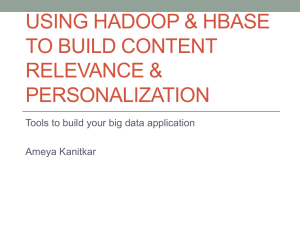Experimenting Lucene Index on HBase in an HPC Environment Xiaoming Gao Vaibhav Nachankar
advertisement
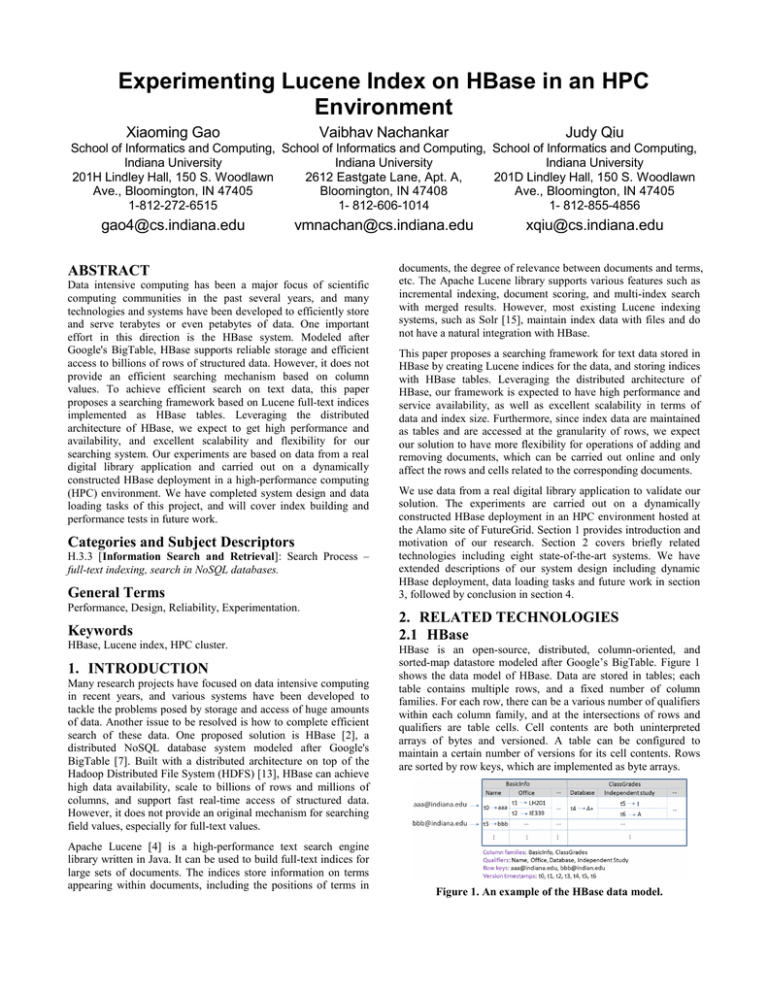
Experimenting Lucene Index on HBase in an HPC
Environment
Xiaoming Gao
Vaibhav Nachankar
Judy Qiu
gao4@cs.indiana.edu
vmnachan@cs.indiana.edu
xqiu@cs.indiana.edu
School of Informatics and Computing, School of Informatics and Computing, School of Informatics and Computing,
Indiana University
Indiana University
Indiana University
201H Lindley Hall, 150 S. Woodlawn
2612 Eastgate Lane, Apt. A,
201D Lindley Hall, 150 S. Woodlawn
Ave., Bloomington, IN 47405
Bloomington, IN 47408
Ave., Bloomington, IN 47405
1-812-272-6515
1- 812-606-1014
1- 812-855-4856
ABSTRACT
Data intensive computing has been a major focus of scientific
computing communities in the past several years, and many
technologies and systems have been developed to efficiently store
and serve terabytes or even petabytes of data. One important
effort in this direction is the HBase system. Modeled after
Google's BigTable, HBase supports reliable storage and efficient
access to billions of rows of structured data. However, it does not
provide an efficient searching mechanism based on column
values. To achieve efficient search on text data, this paper
proposes a searching framework based on Lucene full-text indices
implemented as HBase tables. Leveraging the distributed
architecture of HBase, we expect to get high performance and
availability, and excellent scalability and flexibility for our
searching system. Our experiments are based on data from a real
digital library application and carried out on a dynamically
constructed HBase deployment in a high-performance computing
(HPC) environment. We have completed system design and data
loading tasks of this project, and will cover index building and
performance tests in future work.
documents, the degree of relevance between documents and terms,
etc. The Apache Lucene library supports various features such as
incremental indexing, document scoring, and multi-index search
with merged results. However, most existing Lucene indexing
systems, such as Solr [15], maintain index data with files and do
not have a natural integration with HBase.
This paper proposes a searching framework for text data stored in
HBase by creating Lucene indices for the data, and storing indices
with HBase tables. Leveraging the distributed architecture of
HBase, our framework is expected to have high performance and
service availability, as well as excellent scalability in terms of
data and index size. Furthermore, since index data are maintained
as tables and are accessed at the granularity of rows, we expect
our solution to have more flexibility for operations of adding and
removing documents, which can be carried out online and only
affect the rows and cells related to the corresponding documents.
General Terms
We use data from a real digital library application to validate our
solution. The experiments are carried out on a dynamically
constructed HBase deployment in an HPC environment hosted at
the Alamo site of FutureGrid. Section 1 provides introduction and
motivation of our research. Section 2 covers briefly related
technologies including eight state-of-the-art systems. We have
extended descriptions of our system design including dynamic
HBase deployment, data loading tasks and future work in section
3, followed by conclusion in section 4.
Keywords
2. RELATED TECHNOLOGIES
2.1 HBase
Categories and Subject Descriptors
H.3.3 [Information Search and Retrieval]: Search Process –
full-text indexing, search in NoSQL databases.
Performance, Design, Reliability, Experimentation.
HBase, Lucene index, HPC cluster.
1. INTRODUCTION
Many research projects have focused on data intensive computing
in recent years, and various systems have been developed to
tackle the problems posed by storage and access of huge amounts
of data. Another issue to be resolved is how to complete efficient
search of these data. One proposed solution is HBase [2], a
distributed NoSQL database system modeled after Google's
BigTable [7]. Built with a distributed architecture on top of the
Hadoop Distributed File System (HDFS) [13], HBase can achieve
high data availability, scale to billions of rows and millions of
columns, and support fast real-time access of structured data.
However, it does not provide an original mechanism for searching
field values, especially for full-text values.
Apache Lucene [4] is a high-performance text search engine
library written in Java. It can be used to build full-text indices for
large sets of documents. The indices store information on terms
appearing within documents, including the positions of terms in
HBase is an open-source, distributed, column-oriented, and
sorted-map datastore modeled after Google’s BigTable. Figure 1
shows the data model of HBase. Data are stored in tables; each
table contains multiple rows, and a fixed number of column
families. For each row, there can be a various number of qualifiers
within each column family, and at the intersections of rows and
qualifiers are table cells. Cell contents are both uninterpreted
arrays of bytes and versioned. A table can be configured to
maintain a certain number of versions for its cell contents. Rows
are sorted by row keys, which are implemented as byte arrays.
Figure 1. An example of the HBase data model.
HBase runs on top of HDFS, the architecture of which is shown in
Figure 2. Tables are horizontally split into regions, and regions are
assigned to different region servers by the HBase master. Regions
are further vertically divided into stores by column families, and
stores are saved as store files in HDFS. Data replication in HDFS
ensures high availability of table data in HBase. During the
runtime operations of the HBase, the ZooKeeper [6] is used to
coordinate the activities of the master and region servers, and to
save a small amount of system metadata.
With SolrCloud, the index data are split into shards and hosted on
different servers in a cluster. Requests are distributed among shard
servers, and shards can be replicated to achieve high availability.
Katta [10] is an open-source distributed search system that
supports two types of indices: Lucene indices and Hadoop
mapfiles. A Katta deployment contains a master server and a set
of content servers. The index data are also split into shards and
stored on content servers, while the master server manages nodes
and shard assignment.
ElasticSearch [9] is another open-source distributed Lucene index
system. It provides a RESTful service interface, and uses a JSON
document format. In a distributed ElasticSearch deployment, the
index data are also cut into shards and assigned to different data
nodes. Furthermore, there is not a node in a master role; all nodes
are equal data nodes and each node can accept a request from a
client, find the right data node to process the request, and finally
forward the results back to the client.
Figure 2. HBase architecture.
HBase supports efficient data access based on row keys, column
families and qualifiers, but does not provide a native mechanism
for searching cell data. There is existing work on building indices
on HBase tables [8], but it is focused on indexing basic-type field
values such as strings, numbers and dates. While supporting range
search with these indices, it does not address full-text search. Our
work in this paper concentrates on supporting full-text search on
data stored in HBase by building Lucene indices as HBase tables.
2.2 Pig and Hive
Pig [5] is a platform for analyzing large data sets that consists of a
high-level language for expressing data analysis programs, and an
infrastructure for evaluating these programs. With its "Pig Latin"
language, users can specify a sequence of data operations such as
merging data sets, filtering them, and applying functions to
records or groups of records. This provides ease of programming
and also provides optimization opportunities.
Hive [3] is a data warehouse system for Hadoop [1] that facilitates
easy data summarization, ad-hoc queries, and the analysis of large
datasets stored in Hadoop compatible file systems. Hive also
provides a language, HiveQL, for data operations, which closely
resembles SQL.
Pig Latin and HiveQL both have operators that complete search
activities, but the search is done by scanning the dataset with a
MapReduce program and selecting the data of interests. Pig and
Hive are mainly designed for batched data analysis on large
datasets. In comparison, our solution aims at supporting real-time
search on data stored in tables based on use of indices.
2.3 Solr, ElasticSearch, and Katta
Solr is a widely used enterprise level Lucene index system.
Besides the functionality provided by the Apache Lucene library,
Solr offers an extended set of features, including query language
extension, various document formats such as JSON and XML, etc.
It also supports distributed indexing by its SolrCloud technique.
Permission to make digital or hard copies of all or part of this work for
personal or classroom use is granted without fee provided that copies are
not made or distributed for profit or commercial advantage and that
copies bear this notice and the full citation on the first page. To copy
otherwise, or republish, to post on servers or to redistribute to lists,
requires prior specific permission and/or a fee.
SuperComputing’11, Nov. 12–18, 2011, Seattle, WA, USA.
Copyright 2010 ACM 1-58113-000-0/00/0010…$10.00.
Contrary to our solution, SolrCloud, Katta, and ElasticSearch all
manage index shards with files and thus do not have a natural
integration with HBase. While each of these systems has its own
architecture and data management mechanisms, ours leverages the
distributed architecture of HBase to achieve load balance, high
availability and scalability, and concentrates on choosing the right
index table designs for the best search performance.
2.4 Cassandra and Solandra
Cassandra [12] is another open-source NoSQL database system
modeled after BigTable. Different from HBase, Cassandra is built
on a peer-to-peer architecture with no master nodes, and manages
table data storage by itself, instead of relying on an underlying
distributed file system. Solandra [14] is a Cassandra-based Lucene
index system for supporting real-time searches. Similar to our
solution, Solandra also maintains the index data in Cassandra
tables, but the table schemas are different from ours. Compared
with Solandra, our solution not only serves efficient real-time
searches, but also provides better support for large scale parallel
analysis on the index data because of the inherent MapReduce
support in HBase.
3. SYSTEM DESIGN AND
IMPLEMENTATION
3.1 Problem Definition
We use a real digital library application to demonstrate our
Lucene index implementation based on HBase, and to test our
system's design and performance. To clarify the problem that we
are targeting, this subsection gives a brief description of the
requirements and data organization of the application.
The basic requirements of the application are to store the digital
library data and to serve queries from users. A user submits a
query for books from a web interface, gets a list of information
related to his/her query, and selects the books of interest to read
their text or image content. A query is composed of a set of terms
from one or more fields, and can be expressed in the form of
{<field1>: term1, term2, ...; <field2>: term1, term2, ...; ...}. For
example, a query expressed as {title: "computer"; authors:
"Radiohead"; text: "Let down"} is looking for a book written by
Radiohead which contains "computer" in the title and "Let down"
in the text. A query result is a list of books that contain the
specified terms in their corresponding fields.
The whole dataset currently contains ~50GB of data, composed of
three parts: bibliography data in XML files, image data in .png
and .tif files, and text data in .txt files. The bibliography data
contain metadata about books, including title, category, authors,
publishers, keywords, etc. The image data contains images created
by scanning pages in books, and the text data contains texts
extracted from the images. We save all kinds of data in HBase
tables, and we create Lucene indices for bibliography data and
text data. The indices are also saved in HBase tables.
3.2 Architecture and Workflow
Figure 3. System architecture.
Figure 3 shows the system architecture of our digital library
application. We create three tables in HBase to store the
bibliography, text, and image data of the books, and one Lucene
index table to store the index for bibliography and text data. The
table schemas are given in Table 1, expressed in the format of
"<row key> --> {<column family>: [<qualifier>, <qualifier>, ...];
<column family>: [<qualifier>, <qualifier>, ...]; ...}". The
schemas of the first three tables are self-explainable. In the
Lucene index table schema, each row corresponds to a different
term value, and is composed of multiple column families, each
containing information about the documents having that term
value in a specific field. A "<doc id>" will be "<book title><seq>" at run time, and the cell data will be the position vector of
the corresponding book for the term value.
Table 1. HBase table schemas
Table name
Book
bibliography
table
Book text
data table
Book image
data table
Schema
<book title>-<seq> --> {md:[category, authors,
createdYear, publishers, location, startPage,
currentPage, ISBN, additional, dirPath,
keywords]}
to a very fast indexing process. Once the index table is built up,
we can have data analysis applications implemented as
MapReduce jobs running directly over the index table.
Third, since HBase provides atomic mutations at the level of
rows, the index data are maintained at the granularity of term
values. This suggests the feasibility of adding or deleting a
document in real-time with little interference to the system
performance. To add or delete a document, for each unique term
in the document we only need to add a set of <qualifier, value>
pairs or mark a set of <qualifier, value> pairs as deleted in its
corresponding row, which only imposes a very small impact on
concurrent accesses to the same row.
The whole system works as follows. A user submits a query
through a client program. Using the terms in the query as row
keys, the client program will first get a list of titles for the books
which contain those terms in their corresponding fields. Then,
using the book titles as row keys, the client will get the
bibliography data for the books and return them to the user.
Finally, the user will select books of their interests, and the client
program will access the corresponding text or image data upon the
user's requests.
Figure 4 shows the workflow of the major tasks that need to be
executed to build and test the system. All tasks and experiments
are carried out in the Amalo HPC cluster of FutureGrid, and
before any task is executed, the whole dataset is first loaded into a
distributed file system mounted on Alamo. The first task is to
dynamically construct a distributed HBase deployment in Alamo.
After that is done, the bibliography data are loaded from the XML
files to the bibliography table in HBase. Since the bibliography
table contains file system paths to the text and image data files, it
is then used as input for the text and image data loading tasks,
which will store the data into HBase tables. The bibliography and
text data table will then be used by the Lucene index-building
task, and the indices will be stored in an index table. Finally, we
can either launch a performance evaluation task to test the
efficiency and scalability of the index system, or complete further
data analysis tasks on the text data table or index table.
<book title>-<seq> --> {pages:[1, 2, ...]}
<book title>-<seq>-<page number> -->
{image:[image]}
<term value> --> {title:[<doc id>, <doc-id>, ...];
category:[<doc id>, <doc id>, ...];
Lucene
authors:[<doc id>, <doc id>, ...];
index table
keywords:[<doc id>, <doc id>, ...];
texts:[<doc id>, <doc id>, ...]}
This architecture has the following advantages for supporting a
Lucene index system:
First, by leveraging the distributed architecture of HBase, the
index table is split into regions, which are assigned across all
region servers. Therefore, the total throughput of the index system
scales with the number of region servers. Moreover, since table
data are replicated in HDFS, the index data are of high
availability, and its size scales with the capacity of HDFS.
Second, since Hadoop has original support for MapReduce jobs
using HBase tables as input, we can develop MapReduce
programs for building the index table in a parallel manner, leading
Figure 4. Workflow of major tasks.
3.3 Current Progress
We modified the MyHadoop [11] software to complete the
dynamic HBase deployment task. MyHadoop is a software
package that can be used to dynamically construct a distributed
Hadoop deployment in an HPC environment. It is mainly
composed of two parts: a set of template Hadoop configuration
files, and a set of scripts working with HPC job systems, which
apply for HPC nodes, configure nodes as Hadoop masters and
slaves, start Hadoop daemon processes on these nodes, and then
launch MapReduce jobs on the constructed Hadoop system. The
flow chart of the MyHadoop scripts are shown at the left side of
Figure 5. We added template configuration files for HBase to
MyHadoop and added operations in the scripts for configuring
ZooKeeper, HBase master and region servers, and for starting
HBase daemon processes and applications. We call our modified
MyHadoop package "MyHBase", and the flow chart is shown at
the right side of Figure 5.
Figure 5. MyHadoop and MyHBase.
The Bibliography data loading task is completed by a modified
version of the "SampleUploader" MapReduce program. The
"SampleUploader" takes a comma separated text file as input, and
passes each line as a value to a mapper task. The mapper parses
each line in the format of "<row>, <column family>, <qualifier>,
<value>", and converts it to a "Put" object, which is emitted as an
intermediate input value for reducers. The reducer takes over the
"Put" objects and stores them into the bibliography table. We
implemented a pre-processing program to read in all the XML
files containing bibliography data, and generate a big text file as
input to the "SampleUploader". Since many values of the
bibliography data contain commas, we used "###" as a separator
and modified the "SampleUploader" to adapt to this change.
The book text data loading task and image data loading task are
completed by two MapReduce programs. These programs take the
bibliography table as input, and pass each row as a <key, value>
pair to their mappers. The mapper gets the file system path of the
text or image data, and emits a "Put" object containing the data as
an intermediate input value for reducers. The reducers then store
these "Put" objects into the text and image data tables.
3.4 Prospected Future Work
First, our immediate next step will be to implement MapReduce
programs for building the Lucene index table. The programs will
take rows of the bibliography table and text data table as input to
mappers, which generate partial index data for each term, and the
reducers will then collect the results from different mappers and
generate the complete index table. The index table schema may be
adjusted depending on performance considerations, and we will
try to add scores to the index, either by adding new qualifiers to
the existing table schema, or by creating a separate table for it.
Second, we will implement a distributed benchmarking program
to evaluate the performance of the index system. The program
will imitate the activities of multiple distributed clients, and
generate queries based on samples of real use cases. Besides
query efficiency, we will also evaluate the scalability of the index
system as the number of HBase region servers increase, as well as
the flexibility in terms of adding or removing documents.
Third, we will develop some MapReduce programs that perform
data analysis on Lucene index data to demonstrate the advantages
of our solution in MapReduce support. We plan to carry out these
further steps in the next three months.
4. CONCLUSIONS
HBase is an open-source implementation of the BigTable system
that originated from Google. Built with a distributed architecture
on top of HDFS, HBase can support reliable storage and efficient
access of a huge amount of structured data. However, it does not
provide an efficient mechanism for searching field values,
especially for full-text search. This paper proposes a distributed
Lucene index solution to support interactive real-time search for
text data stored in HBase. By hosting Lucene indices directly with
HBase tables, we expect to leverage the distributed architecture of
HBase and achieve high performance and better scalability and
flexibility for the indexing system. By modifying the MyHadoop
software package we developed MyHBase, which can
dynamically construct a distributed HBase deployment in an HPC
environment. Our experiments were conducted on the Alamo
HPC cluster of FutureGrid, using data from a real digital library
application. We have completed the data loading processes, and
expect to continue with the index building and performance
evaluation parts of our research within the next couple of months.
5. REFERENCES
[1] Apache Hadoop, http://hadoop.apache.org/.
[2] Apache HBase, http://hbase.apache.org/.
[3] Apache Hive, http://hive.apache.org/.
[4] Apache Lucene, http://lucene.apache.org/.
[5] Apache Pig, http://pig.apache.org/.
[6] Apache ZooKeeper, http://zookeeper.apache.org/.
[7] Chang, F., Dean, J., Ghemawat, S., Hsieh, W., Wallach, D.,
Burrows, M., Chandra, T., Fikes, A. and Gruber, R. Bigtable:
A Distributed Storage System for Structured Data. In
Proceedings of the 7th Symposium on Operating System
Design and Implementation (Seattle, WA, USA, November
06-08, 2006).
[8] Dumon, B. Building indexes using HBase: mapping strings,
numbers and dates onto bytes.
http://brunodumon.wordpress.com/2010/02/17/buildingindexes-using-hbase-mapping-strings-numbers-and-datesonto-bytes/.
[9] ElasticSearch, http://www.elasticsearch.org/.
[10] Katta, http://katta.sourceforge.net/.
[11] Krishnan, S., Tatineni, M. and Baru, C. MyHadoop –
Hadoop-on-Demand on Traditional HPC Resources. San
Diego Supercomputer Center Technical Report TR-2011-2,
University of California, San Diego, 2011.
[12] Lakshman, A. and Malik, P. Cassandra - A Decentralized
Structured Storage System. In Proceedings of The 3rd ACM
SIGOPS International Workshop on Large Scale Distributed
Systems and Middleware (Big Sky, MT, USA, October 1011, 2009).
[13] Shvachko, K., Kuang, H., Radia, S. and Chansler, R. The
Hadoop Distributed File System. In Proceedings of the 26th
IEEE (MSST2010) Symposium on Massive Storage Systems
and Technologies (Incline Village, Nevada, May 03 - 07,
2010).
[14] Solandra, https://github.com/tjake/Solandra.
[15] Solr, http://lucene.apache.org/solr/.

